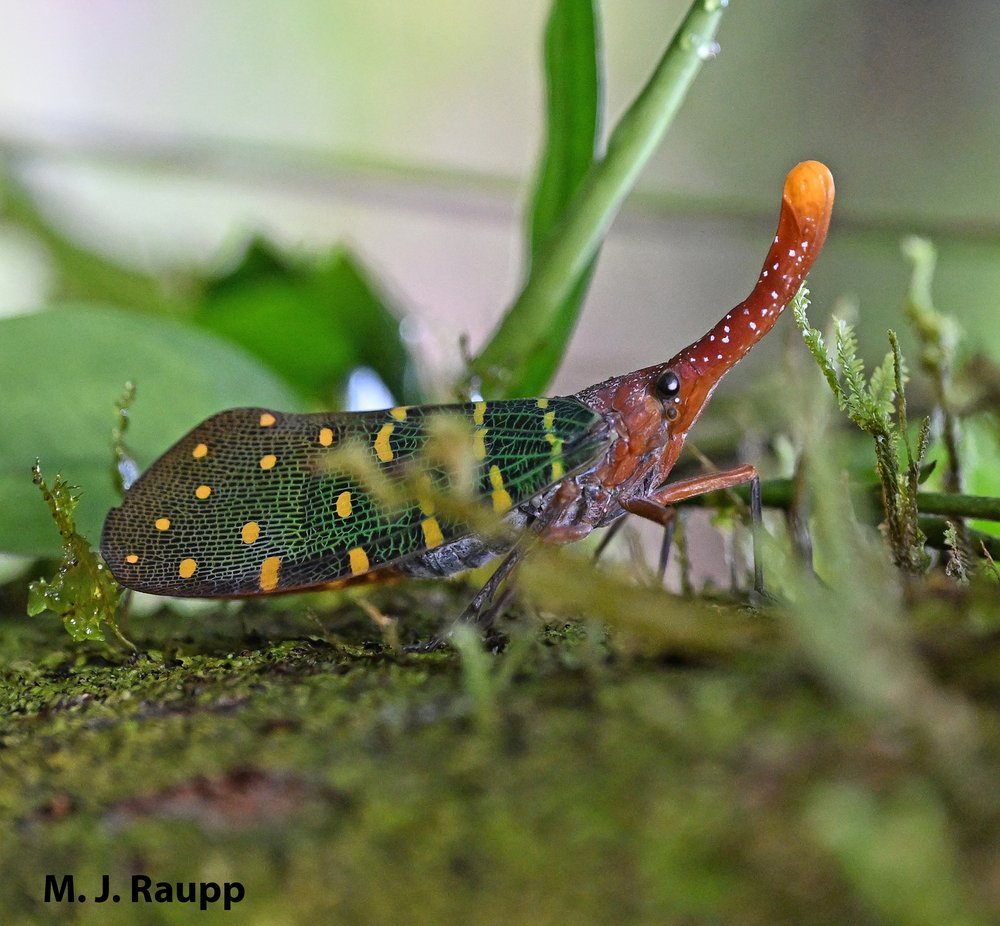
Does the bulb at the tip of Pyrops intricatus’ headgear really produce light?
Over the past several years, we learned much about the mischief caused by the spotted lanternfly, Lycorma delicatula, as it spreads, continuing its depredations of vineyards, and creating problems such as fouling plants with honeydew, attracting stinging insects, and generally freaking-out humans with its vast numbers and bumbling behaviors. To see another side of lanternflies, we return to Borneo, a biodiversity hotspot where last week we met a fascinating collection of millipedes and centipedes.
Lanternflies belong to a group of insects known as the Hemiptera. Unlike caterpillars or beetles that munch leaves with jaws, Hemiptera use soda-straw-like sucking mouthparts to remove sweet phloem sap from plants. Immature feeding stages of Hemiptera are called nymphs, rather than larvae. Within the taxonomic order Hemiptera, lanternflies belong to a family called Fulgoridae. How do fulgorids come by the name lanternfly? One account has it that famed German naturalist and illustrator Maria Sibylla Merian coined the moniker “lanternfly” after encountering these strange insects with bizarre ornamentation on their heads while on an expedition to Surinam in the early 1700s. She mistakenly believed these adornments could produce light at night, perhaps for the purpose of mating. If you look at the images herein, it certainly looks like those horns could light up, right? Alas, they don’t emit light, but the name lanternfly has stuck to this day.
A nighttime walk in the rainforest provides an exciting chance to search for lanternflies. A pair of ghost-like Pyrops sultanus rest on the trunk of a tree. In the morning light their magnificent head decoration is revealed. One look at the bulb on the tip of Pyrops intricatus’ headgear explains why they were believed to be luminescent. A bright blue horn decorates the head of Pyrops whiteheadi and for obvious reasons some call Zanna nobilis the crocodile lanternfly. A pretty Penthicodes lanternfly rests on reed near the riverbank. Nothing goes to waste in the rainforest. Once their time in the rainforest is through, ants quickly recycle the remains of lanternflies.
As we learned with spotted lanternfly, these sap-feeders excrete vast quantities of the carbohydrate rich waste product known as honeydew. We also learned that several stinging insects, hornets, yellow jackets, paper wasps, and even honeybees are attracted to trees infested with lanternflies to gather honeydew, a food for themselves and their brood. Do Bornean lanternflies produce honeydew attractive to other creatures? You bet they do. Some of the species depicted in this episode in the genus Pyrops participate in an ecological association known as trophobiosis, a deal between different organisms where one produces food for another. The species providing food is called a trophobiont. Observations by naturalists and researchers revealed that lanternflies are attended by geckos and cockroaches. Assuming a post near the derriere of lanternflies, they collect sweet honeydew as it Is produced. Clever beasts. Scientists today still remark that little is known about the biology and ecology of lanternflies. Hopefully, enough unique rainforest habitats can be saved to prevent the loss of these gorgeous creatures and their compatriots in Bornean rainforests and other biodiversity hotspots around the world.
Acknowledgements
We thank our dauntless guides, Leo on the Kinabatangan River, Larry at Mulu National Park and Oliver at Tabin Wildlife Reserve for braving the rivers and rainforest trails to help us find insects. The keen eyes of Dan, Kristie, Bob, Pat, and Paula helped spot lanternflies featured in this episode. The interesting articles “Review of the effusus group of the Lanternfly genus Pyrops Spinola, 1839, with one new species and notes on trophobiosis (Hemiptera: Fulgoromorpha: Fulgoridae) by Jérôme Constant, and “The Beauty of Life - Lantern Flies” by Aub Podlich contributed greatly to this article, as did images provided by Chien C. Lee at Wild Borneo Photography.
No comments:
Post a Comment